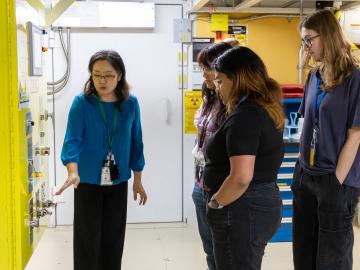
Filter News
Area of Research
- Advanced Manufacturing (5)
- Biology and Environment (21)
- Computational Biology (1)
- Computational Engineering (1)
- Computer Science (1)
- Energy Science (74)
- Energy Sciences (1)
- Fusion and Fission (5)
- Isotopes (20)
- Materials (53)
- Materials for Computing (7)
- Mathematics (1)
- National Security (14)
- Neutron Science (81)
- Nuclear Science and Technology (7)
- Quantum information Science (1)
- Supercomputing (19)
News Type
News Topics
- (-) Clean Water (31)
- (-) Composites (22)
- (-) Coronavirus (31)
- (-) Cybersecurity (17)
- (-) Energy Storage (69)
- (-) Isotopes (40)
- (-) Neutron Science (112)
- (-) Physics (43)
- 3-D Printing/Advanced Manufacturing (93)
- Advanced Reactors (26)
- Artificial Intelligence (94)
- Big Data (67)
- Bioenergy (86)
- Biology (102)
- Biomedical (55)
- Biotechnology (29)
- Buildings (55)
- Chemical Sciences (50)
- Computer Science (159)
- Critical Materials (18)
- Education (2)
- Emergency (4)
- Environment (172)
- Exascale Computing (52)
- Fossil Energy (7)
- Frontier (46)
- Fusion (49)
- Grid (56)
- High-Performance Computing (94)
- Hydropower (12)
- Irradiation (2)
- ITER (7)
- Machine Learning (54)
- Materials (89)
- Materials Science (98)
- Mathematics (12)
- Mercury (10)
- Microelectronics (3)
- Microscopy (38)
- Molten Salt (7)
- Nanotechnology (33)
- National Security (66)
- Nuclear Energy (90)
- Partnerships (37)
- Polymers (21)
- Quantum Computing (39)
- Quantum Science (60)
- Security (19)
- Simulation (53)
- Software (1)
- Space Exploration (23)
- Statistics (3)
- Summit (48)
- Transportation (71)
Media Contacts

Debjani Singh, a senior scientist at ORNL, leads the HydroSource project, which enhances hydropower research by making water data more accessible and useful. With a background in water resources, data science, and earth science, Singh applies innovative tools like AI to advance research. Her career, shaped by her early exposure to science in India, focuses on bridging research with practical applications.

At ORNL, a group of scientists used neutron scattering techniques to investigate a relatively new functional material called a Weyl semimetal. These Weyl fermions move very quickly in a material and can carry electrical charge at room temperature. Scientists think that Weyl semimetals, if used in future electronics, could allow electricity to flow more efficiently and enable more energy-efficient computers and other electronic devices.

Benjamin Manard, an analytical chemist in the Chemical Sciences Division of the Department of Energy’s Oak Ridge National Laboratory, will receive the 2024 Lester W. Strock Award from the Society of Applied Spectroscopy.

The 26th annual National School on Neutron and X-ray Scattering School concluded on August 9, 2024. Each year, more than 200 graduate students in North America studying physics, chemistry, engineering, biological matter and more compete to participate in NXS. However, given limited space, only 60 can be accepted. The school exposes graduate students to neutron and X-ray scattering techniques through lectures, experiments, and tutorials.

Scientists have determined that a rare element found in some of the oldest solids in the solar system, such as meteorites, and previously thought to have been forged in supernova explosions, actually predate such cosmic events, challenging long-held theories about its origin.

Two ORNL teams recently completed Cohort 18 of Energy I-Corps, an immersive two-month training program where the scientists define their technology’s value propositions, conduct stakeholder discovery interviews and develop viable market pathways.

Brittany Rodriguez never imagined she would pursue a science career at a Department of Energy national laboratory. However, after some encouraging words from her mother, input from key mentors at the University of Texas Rio Grande Valley, or UTRGV, and a lot of hard work, Rodriguez landed at DOE’s Manufacturing Demonstration Facility, or MDF, at Oak Ridge National Laboratory.

Researchers conduct largest, most accurate molecular dynamics simulations to date of two million correlated electrons using Frontier, the world’s fastest supercomputer. The simulation, which exceed an exaflop using full double precision, is 1,000 times greater in size and speed than any quantum chemistry simulation of it's kind.

ORNL's Guang Yang and Andrew Westover have been selected to join the first cohort of DOE’s Advanced Research Projects Agency-Energy Inspiring Generations of New Innovators to Impact Technologies in Energy 2024 program. The program supports early career scientists and engineers in their work to convert disruptive ideas into impactful energy technologies.

Researchers used quantum simulations to obtain new insights into the nature of neutrinos — the mysterious subatomic particles that abound throughout the universe — and their role in the deaths of massive stars.


